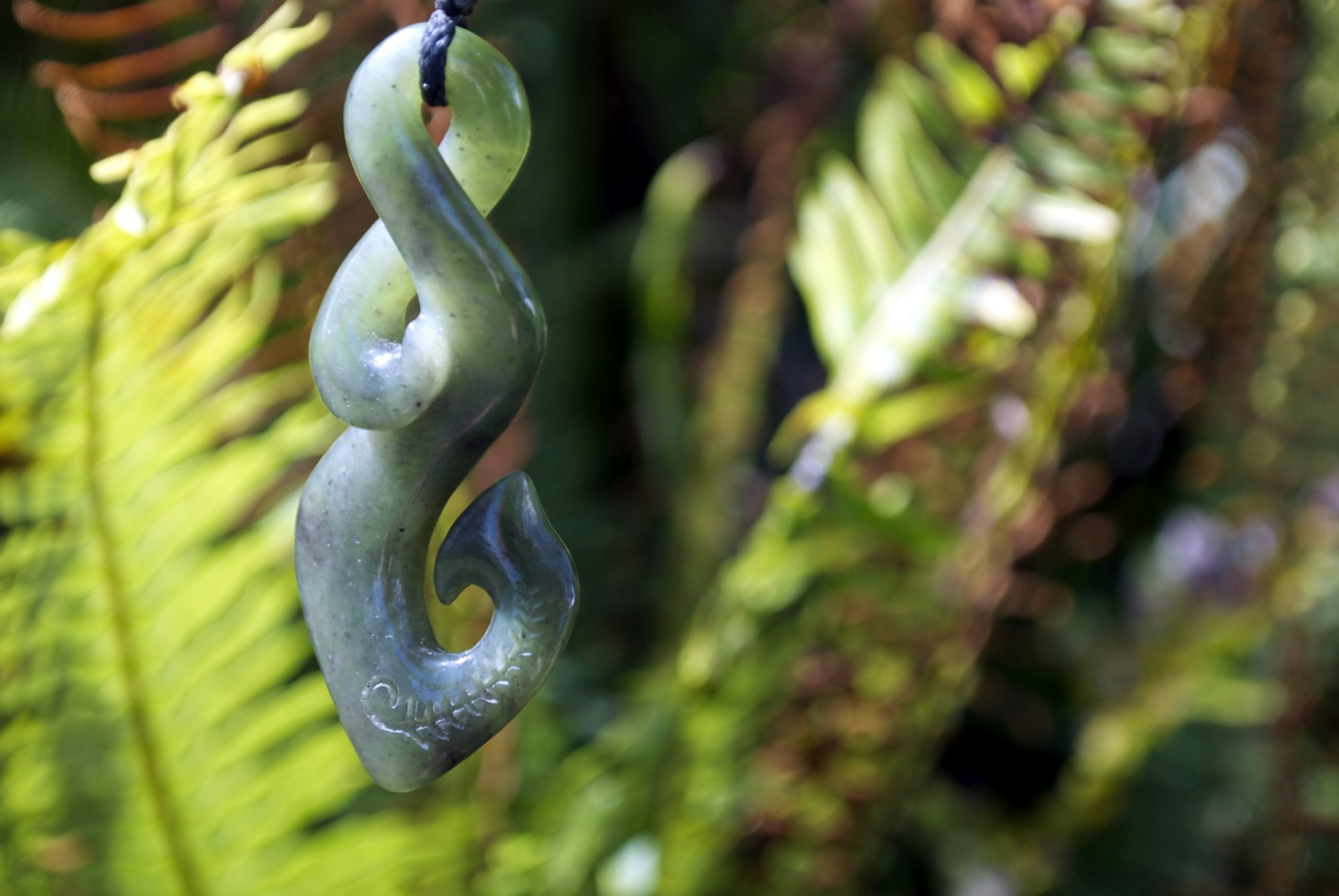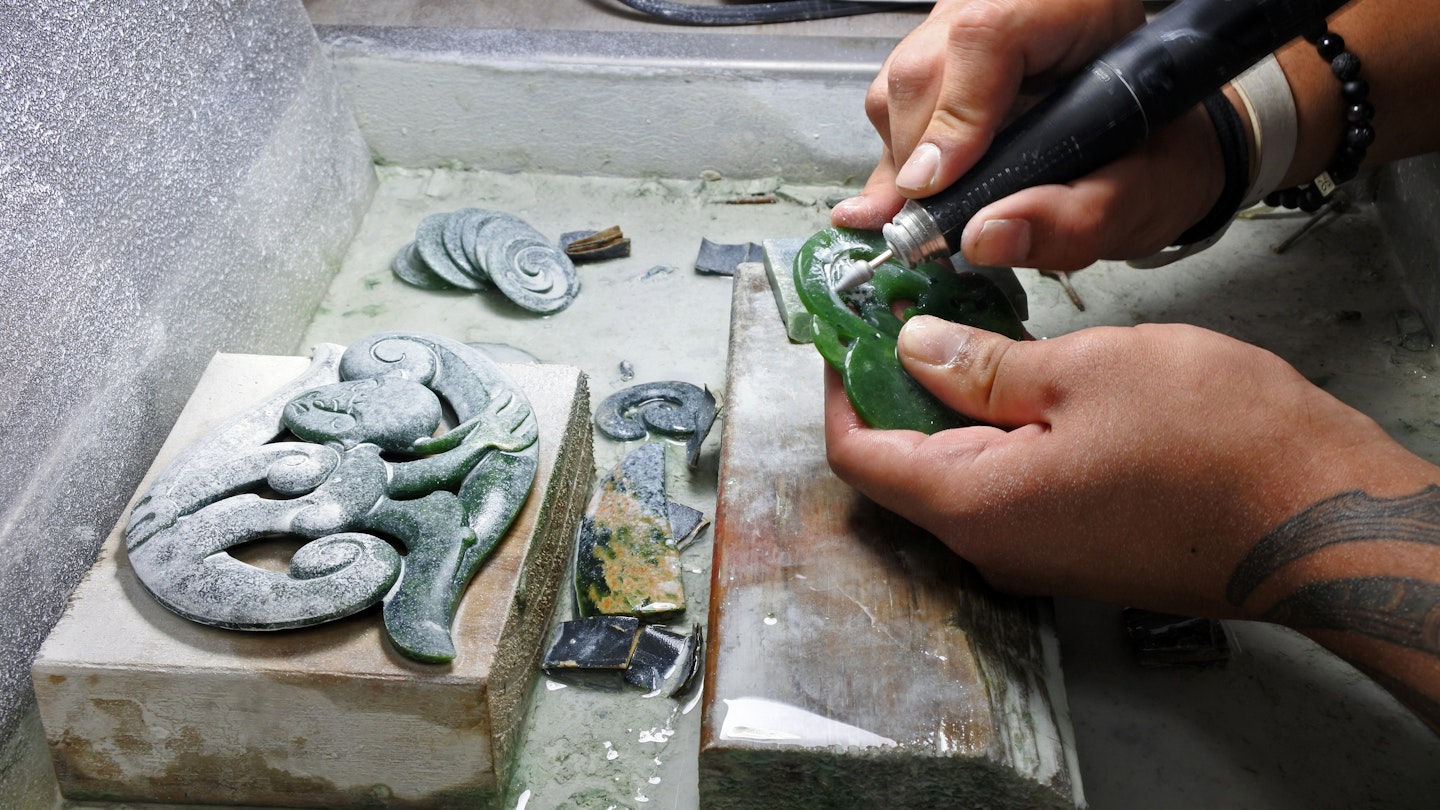As soon as you arrive in New Zealand, you’ll notice the greenstone (pounamu in Māori) pendants, often attached to a leather necklace, around the necks of many locals and tourists.
They’re among the most popular souvenirs for sale here, and it’s almost de rigueur for visitors to buy one as soon as possible and wear it proudly as they travel around the country. But look more closely and you’ll also soon discover that not all pounamu is the same.
As a teenager, my father (a New Zealander himself) gave me a pounamu hei-tiki as a gift after he’d been back home. I hate to admit it, but I never even really thought what it meant, I just knew it was an iconic Māori design. I loved the way it felt in my hands and I wore it on a leather necklace for years – including in my first adult passport photo.
Later I found out the tiki is a fertility symbol, so when the time came to try to get pregnant I wore it once more. Oh and, yes it worked!
So here’s the lowdown on what to consider when buying a pounamu souvenir (whether it's bad luck to buy it for yourself is open for debate). We cover certificates of authenticity, and the significance of the main four designs you’ll see, so that you can purchase a quintessential New Zealand gift with as much mana (power) as possible.

Is there a difference between greenstone, jade and pounamu?
Greenstone, also known as jade, is a semiprecious gemstone ranging in color from cloudy light green to a deep emerald hue. (Two distinct minerals are sold as “jade” – jadeite and nephrite. They have similar physical properties, but nephrite is the more common – and therefore less valuable – of the two).
A very durable material, greenstone can be carved into a variety of objects, from weapons and tools to ornamental jewelry. And in multiple cultures, it’s believed to have healing powers.
The greenstone found in New Zealand, pounamu, comes specifically from the west coast of the South Island, the land of the Ngāi Tahu iwi (community). In 1997, the NZ government returned the ownership and guardianship rights (kaitiaki in Māori) for New Zealand’s pounamu to the Te Rūnanga o Ngāi Tahu (the elected tribal council of the Ngāi Tahu people).
This means the Ngāi Tahu iwi are responsible for sustainably managing pounamu in New Zealand, as well as ensuring that the rivers it comes from, like the Arahura River, are protected and cared for.
In fact, the southwest region, Te Wāhipounamu (“the place of pounamu”), is World Heritage–listed because it is the largest and least modified part of New Zealand's natural ecosystem, thanks in no small part to its First Nations inhabitants.
Why is some pounamu more expensive than others?
As with any gemstone, the value of each piece of pounamu is determined by its aesthetic quality and its scarcity. Māori classify pounamu according to color, markings and translucency. The four main varieties are called inanga, kahurangi, kawakawa and tangiwai.
Kahurangi pounamu is the rarest of New Zealand greenstone, highly translucent and free from dark spots or other flaws. Inanga pounamu takes its name from a freshwater fish and is usually an opaque grey–green color. Tangiwai is more translucent, but also more brittle, making it harder to work with. The more common kawakawa pounamu comes in many different shades of green and is easier to work with.

How do I make sure I am buying real New Zealand pounamu?
If you’re traveling on a budget you might balk at the price difference between inauthentic imported greenstone and the genuine article.
Some of the cut-price pounamu you’ll see in souvenir stores may have been carved in New Zealand, but use raw material from overseas. Other cheaper items are actually mass-manufactured elsewhere and sold to unsuspecting travelers as a local product.
If you want to support traditional craftspeople and take home a souvenir with a genuine spiritual connection to Māori culture, you’ll need to keep some of your spending money aside and look for items that have Ngāi Tahu authentication. A simple design will be around NZ$100 to NZ$200 (USD$62 to USD$125); a more elaborate piece can cost up to NZ$600 (nearly USD$400) depending on the quality of the stone.
A traceability code will give you more information about the whakapapa (genealogy) of your stone, as well as the artist who carved it. For an even more meaningful pounamu experience, visit the studios and jewelers on the South Island and talk to the artisans directly.
Why are some pounamu pieces carved in particular styles?
As well as looking after the environment, the Ngāi Tahu iwi are also the proud custodians of pounamu carving skills and traditions, and craftspeople who work with real pounamu value both the spiritual and aesthetic beauty of the stones they work with.
Lee-Roy Mullings, of Ngāti Kahungunu iwi, has worked at Arrowtown Stonework workshop for over 30 years. "Before I start carving, I acknowledge the cultural significance of the stone. I connect with its unique qualities: the grain, clarity, and color. It's more than just shaping, it's a transformation, infused with meaning and Māori tradition," he explains.

What is the meaning of the main pounamu pendant designs?
You’ll see four main designs being sold across New Zealand (which are also sometimes presented in stone, shell or bone).
The toki is an everyday tool for cutting, similar to a small axe, and symbolizes wisdom, strength and determination; it can be worn by men and women, but has traditionally been worn by elders. The koru, an unfurling native fern, represents new beginnings, growth and hope. The hei matau, the fishhook design, symbolizes a connection to the ocean but also brings the wearer good luck and safe travels. The hei-tiki design looks a bit like a human embryo; as a result it’s often said to be a fertility symbol, but its meaning can also vary according to context.
Can you find pounamu in the wild?
Anyone can go beachcombing for pounamu pebbles along the West Coast of the South Island, but you’re not allowed to hunt for the gemstone in its rivers.
In a sad (but perhaps unsurprising) twist, as pounamu has become more valuable, there’s also been an increase in looting of the stone from more remote regions. It’s a crime that is acknowledged to cause spiritual offense to the Ngāi Tahu, not to mention economic loss for the community.
If you’d like to learn more about the history and importance of pounamu from the locals, you can book yourself on a “fossicking” (prospecting) tour with registered Ngāi Tahu guides – recommended outfits include Arahura Greenstone Tours and Te Rua & Sons Pounamu Trails.
For a lesson on carving your own pounamu (or bone or shells), enquire about courses with Bonz N Stonz, a boutique artist studio in Hokitika on New Zealand’s West Coast.
And, finally, if you ensure you're buying an authentic piece of pounamu, you can wear your piece proudly knowing you're supporting the continuation of Māori cultural inheritance, with a beautiful and authentic keepsake from your travels in New Zealand.












